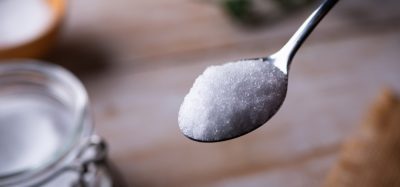The Role Of Fucosylated And Sialylated Human Milk Oligosaccharides In Infant Nutrition
Posted: 6 October 2020 | Clifford A Adams, Jennewein Biotechnologie | No comments yet
Human milk oligosaccharides are the third most abundant component of human milk after lactose and lipids, reaching between 5 and 20 g/L in mature human milk.


The HMOs are all based on five monosaccharides; glucose, galactose, N-acetyl-glucosamine, fucose, and sialic acid, also known as N-acetylneuraminic acid [1]. The monosaccharides fucose and sialic acid are also somewhat unusual and interesting. Fucose is structurally different from other 6-carbon monosaccharides present in mammals as it lacks a hydroxyl group on the carbon at the 6-position (C-6) and it has, the L-configuration whereas most other monosaccharides have the D-configuration [2]. Sialic acid is not only a component of HMOs but is also very important in brain development [3]. There are three major types of HMOs: (1) fucosylated HMOs such as 2′-fucosyllactose (2′-FL), (2) sialylated HMOs such as 3’-sialyllactose (3’-SL) and (3) neutral HMOs such as lacto-N-neotetraose (LNnT). The most abundant HMO in breast milk of about 80% of all women is 2′-FL, which constitutes up to 30% of the total HMOs [4]. There are also wide differences in the production of HMOS by individual women. This is due to the presence or absence of the fucosyltransferase 2 (FUT2) secretor gene. Women with an active FUT2 enzyme are referred to as Secretors as they secrete a substantial amount of 2′-FL. Women with an inactive FUT2 secretor gene lack 2′-FL and are referred to as Non-secretors. The abundance of 2′FL in breast milk is an indicator of secretor status [5].
A further curious aspect of HMOs is that they are indigestible by the new born infant and are therefore not an energy source. It is now recognised that the HMOs have a wide range of bioactivities which are important for health maintenance and disease avoidance in infants. They act as receptor decoys preventing pathogen binding to gastrointestinal epithelial cells and influence gene expression in the epithelial cells [6]. They have a prebiotic function, as they can be used as nutrients by certain bacteria, such as Bifidobacteria. This is important in developing an effective microbiome and avoiding disruption of the microbiome or dysbiosis after lactation. Dysbiosis during early life is a risk factor for immune-mediated diseases, such as allergy and asthma, and intestinal and metabolic diseases [4]. A healthy gastrointestinal microbiome protects the infant against pathogens by enhancing the immune development and stimulating the digestive and metabolic functions.
Effects of Fucosylated HMOs
Fucosylated oligosaccharides represent the largest fraction of HMOs, with the simplest and the most abundant being 2’-FL. In secretor women, fucosylated oligosaccharides, elicit anti-adhesive properties ,against fucose-dependent pathogens, and are crucial for growth and metabolism of beneficial bacteria to shape a healthy microbiome.
Evidence that fucosylated HMOs can exert beneficial effects on the infant microbiome is that they can increase lactate concentrations and the proportion of Bifidobacterium spp. in culture [6]. Their fermentation into organic acids in turn decreased the proportion of Escherichia coli and Clostridium perfringens. During in vitro growth studies, two strains of Bifidobacterium longum efficiently consumed the fucosylated HMOs and produced abundant lactate and short-chain fatty acids (SCFA), resulting in significant pH reduction. E. coli K12 and C. perfringens did not readily utilize fucosylated HMOs and a typical mixture of organic acid fermentation products inhibited their growth [6]. This in vitro work has been further substantiated in infants to show that human milk is a selective growth medium for Bifidobacteria which, establishes colonization resistance against pathogens in the infant gut by lowering the pH [7]
The oligosaccharide 2’-FL specifically promoted the expansion of the commensal bacteria Ruminococcus gnavus which decreased the development of colitis in young mice after weaning [8]. This response was very strong for 2’-FL, while sialylated oligosaccharides failed to induce colitis protection. These results suggest that 2’-FL could delay the onset in individuals with a colitis-prone predisposition in the post-lactation period. Therefore, 2’FL might be an interesting and promising supplement for diet in IBD patients in terms of disease progression [8].
Further confirmation of the influence of fucosylated HMOs on the gastrointestinal microbiome of infants was provided by supplementation of an in vitro digestion model with 2 g/L of 2′-FL [9]. This led to positive effects on the metabolic activity and composition of faecal micro-organisms from 6-month old, formula-fed infants after weaning. Butyrate concentration increased throughout the length of the colon. Clearly, 2′-FL can alter the composition and function of the gastrointestinal microbiome in older formula-fed infants once they have begun the weaning process by increasing the relative abundance of butyrate-producing bacteria. Fucoslylated HMOs have the ability to modify the microbiome for health maintenance and disease avoidance in infants [9].
Inflammatory diseases can develop in early infancy and prevention or reduction of early inflammation may prevent the subsequent development of disease. Control of inflammation by fucosylated HMOs is a distinct advantage and has been demonstrated in a randomized controlled trial with healthy infants from 5 days to 4 months of age [10]. The addition of 2’-FL to infant formula led to lowering of the level of various inflammatory cytokines compared to infant formula without 2’-FL. Moreover, the level of inflammatory cytokines in serum of infants fed with formula supplemented with 2’ -FL was at the same level as for breastfed infants [10].
Diarrhoea is a serious childhood health problem but breastfed infants have a lower risk of diarrhoea than infants fed milk substitutes. This was confirmed with a cohort of 93 Mexican breastfeeding mother-infant pairs [11]. The content of 2’-FL in human milk was significantly associated with lower risk of diarrhoea in breastfed infants. Also the incidence of Campylobacter-induced diarrhoea, occurred less often in infants whose mother’s milk contained high levels of 2′-FL. Calicivirus diarrhoea occurred less often in infants whose mother’s milk contained high levels of lacto-N-difucohexaose, another 2-linked fucosyloligosaccharide [12].
Norovirus infections cause severe gastroenteritis in millions of infants every year. Infection requires the recognition of histo-blood group antigens (HBGAs). Two HMOs, 2’-FL and 3’-FL, are able to block norovirus from binding to surrogate HBGA samples. These fucosylated HMOs might act as naturally occurring decoys in humans [13]. Fucosylated HMOs can be produced by large-scale fermentation and could help to prevent norovirus infections [14].
Fucosylated HMOs have multiple immunomodulatory functions that influence child health. This was demonstrated from a study in Zambia on the effects of HMOs from breast milk on the survival of uninfected children born to HIV-infected mothers. Higher maternal breast milk concentrations of fucosylated HMOs were significantly associated with reduced mortality during breastfeeding [15].
Several studies have also demonstrated that fucosylated HMOs are safe when used to supplement infant formula. In a randomized controlled study of healthy term infants, formulas supplemented with 2’-FL were well tolerated, and 2’-FL absorption profiles were similar to those of breast-fed infants. There were no significant differences in weight, length, and head circumference between infants fed human milk or formulas from birth to 4 months of age [16].
The HMOs, 2’-FL and LNnT have been extensively studied in a randomized, controlled clinical trial [17]. Healthy, term infants received a formula with 2’-FL and LNnT or the same formula without HMOs from enrolment at ≤14 days of age to six months of age and for at least four months as the exclusive diet. The formula with 2’-FL and LNnT was well-tolerated and supported age-appropriate growth. Gastrointestinal symptoms were similar between the groups. Infants receiving formula with 2’-FL and LNnT had significantly softer stools and fewer episodes of night-time wake-ups at age two months. The incidence of different health outcomes was also analysed in this trial. Infants fed the formula with 2’-FL and LNnT compared to infants fed the formula without HMOs had significantly fewer parental reports of bronchitis, reduced incidence of lower respiratory tract infections, and reduced use of antibiotics with protective effects that continued after the 6 months intervention period [17]. These neutral and fucosylated HMOS clearly had important and long lasting beneficial health effects on infants.
Effects of Sialylated HMOs
Sialylated HMOs have a beneficial effect in helping to develop a suitable microbiome, somewhat similar to fucosylated HMOs. Bifidobacterium longum subsp. infantis grows robustly on sialylated HMOs. These HMOs may also inhibit gastrointestinal epithelial cell proliferation and induce cell differentiation. This will promote intestinal maturation in early life [18].
The sialylated HMOs, 3′-SL and 6′-SL, can prevent or reduce in vitro adhesion of pathogens such as Salmonella, various E. coli strains, Vibrio cholerae, Helicobacter pylori, Campylobacter jejuni, and rotavirus [18]. Sialylated HMOs seem to be able to reduce pathogen binding of a wide range of micro-organisms. The occurrence of both sialylated and fucosylated HMOs in breast milk is a very powerful system for protection against microbial pathogens in infants.
Sialylated HMOs also plays an important role in immune function and regulation similar to fucosylated HMOs, 3′-Sialyllactose has anti-inflammatory properties, shown by the reduced mRNA levels of pro-inflammatory cytokines, such as IL-8 and TNF-α, in Caco-2 cells. Sialic acid is an important building block for adequate immune function. This underlines the importance of adequate sialic acid availability in infancy, when proper development of the immune system is important for the prevention of diseases or to combat infections. [18]
Sialic acid is now recognised as having an unique and very important role in supporting the central nervous system and brain growth [3]. Studies with young pigs have shown that sialic acid from dietary sialyllactose was deposited in brain tissue [19]. Breast-fed infants at 5 months of age have nearly twice the amount of total salivary sialic acid compared with formula-fed infants due to sialylated HMOs. The brain sialic acid concentration in breast-fed infants was also significantly higher than that of formula-fed infants, as observed in babies who died from sudden infant death syndrome [20]. Moreover, sialylated HMOs in human milk are highest during early lactation, a time when the brain is taking up sialic acid most rapidly [21]. It seems highly likely that human milk through its content of sialylated HMOs is a source of sialic acid that can be absorbed into brain tissue. Moreover sialic acid plays an important role in brain development and learning ability in infants. Sialylated HMOs may contribute to the observed neurological and intellectual advantages of breastfeeding over formula feeding [22]. Possibly there is a case to study the addition of sialic acid to infant formulas.
Siallylated HMOs undoubtedly play an important role in a diverse range of infant health aspects. The most promising health targets are resistance to infectious disease, particularly gastrointestinal diseases, the immune function, and neonatal brain development. In addition, they may have effects on the gastrointestinal microbiome, gastrointestinal maturation, and control of inflammation.
Conclusion
Fucosylated and sialylated HMOs are a fundamental and potent mechanism of protection afforded by human milk against infectious diseases. Both groups of oligosaccharides influence the development of the microbiome, maturation of the gastrointestinal epithelium and reduce the inflammatory response. Sialylated HMOs in addition play a role in brain development. The various published clinical studies suggest that the addition of HMOs to infant formula is safe and well tolerated, inducing a normal growth [23]. The presence of these specific oligosaccharides in human milk represents one of the of the major differences between cow’s milk and human milk, Some of the HMOs can now be produced by large scale fermentation [14]. This allows the addition of various HMOs to infant formula which would bring infant formula closer to human milk. Moreover, the availability of HMOs provides a basis for future research in designing novel therapeutic agents for the prophylaxis and treatment of disease.
Bibliography
[1] Ayechu-Muruzabal V., et al., “Diversity of human milk oligosaccharides and effects on early life immune development”. Frontiers in Pediatrics 6 (2018): 239, doi: 10.3389/fped.2018.00239.
[2] Becker DJ and Lowe JB., “Fucose: biosynthesis and biological function in mammals.” Glycobiology 13 (2003): 41R-53R, doi: 10.1093/glycob/cwg054.
[3] Wang B., et al. “Brain ganglioside and glycoprotein sialic acid in breastfed compared with formula-fed infants”. American Journal of Clinical Nutrition 78 (2003): 1024–1029.
[4] Hegar B., et al. “The role of two human milk oligosaccharides, 2′-fucosyllactose and lacto-N-neotetraose, in infant nutrition”. Pediatric Gastroenterology Hepatology and Nutrition 22 (2019): 330-340, doi: org/10.5223/pghn.2019.22.4.330
[5] Larsson MW., et al. “Human milk oligosaccharide composition is associated with excessive weight gain during exclusive breastfeeding—An explorative study.” Frontiers in Pediatrics (2019) doi.org/10.3389/fped.2019.00297.
[6] Yu Z-T., et al. “The principal fucosylated oligosaccharides of human milk exhibit prebiotic properties on cultured infant microbiota.” Glycobiology 23 (2013): 169–177, doi:10.1093/glycob/cws138.
[7] Duar RM. ,et al. “Colonization resistance in the infant gut: the role of B. infantis in reducing pH and preventing pathogen growth.” High-Throughput 9 (2020): 7, doi:10.3390/ht9020007.
[8] Grabinger T., et al. “Alleviation of intestinal inflammation by oral supplementation with 2-fucosyllactose in mice.” Frontiers in Microbiology 10 (2019): 1385 doi: 10.3389/fmicb.2019.01385.
[9] Van den Abbeele P., et al. “2′-Fucosyllactose alters the composition and activity of gut microbiota from formula-fed infants receiving complementary feeding in a validated intestinal model”. Journal of Functional Foods 61 (2019): 103484 doi: org/10.1016/j.jf f.2019.103484.
[10] Goehring KC., et al. “Similar to those who are breastfed, infants fed a formula containing 2’-fucosyllactose have lower inflammatory cytokines in a randomized controlled trial”. Journal of Nutrition, 146 (2016): 2559–2566.
[11] Newburg DS., et al. “Innate protection conferred by fucosylated oligosaccharides of human milk against diarrhea in breastfed infants”. Glycobiology 14 (2004): 253-263.
[12] Morrow AL., et al. “Human milk oligosaccharides are associated with protection against diarrhea in breast-fed infants”. Journal of Pediatrics 145 (2004): 297–303.
[13] Weichert S., et al. “Structural basis for Norovirus inhibition by human milk oligosaccharides.” Journal of Virology 90 (2016): 4843-4848.
[14] Derya SM., et al. “Biotechnologically produced fucosylated oligosaccharides inhibit the binding of human noroviruses to their natural receptors”. Journal of Biotechnology 318 (2020): 31-38.
[15] Kuhn L, et al. “Oligosaccharide composition of breast milk influences survival of uninfected children born to HIV-Infected mothers in Lusaka, Zambia”. Journal of Nutrition 145 (2015): 66–72.
[16] Marriage BJ., et al. “Infants fed a lower calorie formula with 2’FL show growth and 2’FL uptake like breast-fed infants.” Journal of Pediatric Gastroenterology and Nutrition 61 (2015): 649–658.
[17] Puccio G., et al. “Effects of infant formula with human milk oligosaccharides on growth and morbidity”. Journal of Pediatric Gastroenterology and Nutrition 64 (2017): 624–631.
[18] ten Bruggencate SJM., et al. ”Functional role and mechanisms of sialyllactose and other sialylated milk oligosaccharides.” Nutrition Reviews 72 (2014): 377–389, doi: 10.1111/nure.12106.
[19] Mudd AT., “Dietary sialyllactose influences sialic acid concentrations in the prefrontal cortex and magnetic resonance imaging measures in corpus callosum of young pigs.” Nutrients 9 (2017): 1297, doi:10.3390/nu9121297.
[20] Wang B., “Molecular mechanism underlying sialic acid as an essential nutrient for brain development and cognition.” Advances in Nutrition 3 (2012): 465S–472S.
[21] Svennerholm L., et al. “Human brain gangliosides: developmental changes from early fetal stage to advanced age.” Biochimica Biophysica Acta 1005 (1989): 109–117.
[22] Anderson, JW., et al. “Breast-feeding and cognitive development: a meta-analysis.” American Journal of Clinical Nutrition 70 (1999): 525–535.
[23] Vandenplas Y., et al. “Human milk oligosaccharides: 2’-fucosyllactose (2’-FL) and lacto-N-neotetraose (LNnT) in infant formula.” Nutrients 10 (2018): 1161, doi: 10.3390/nu10091161.









